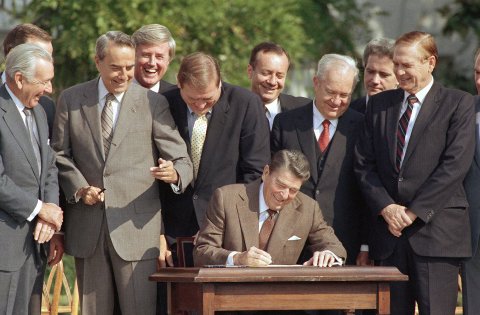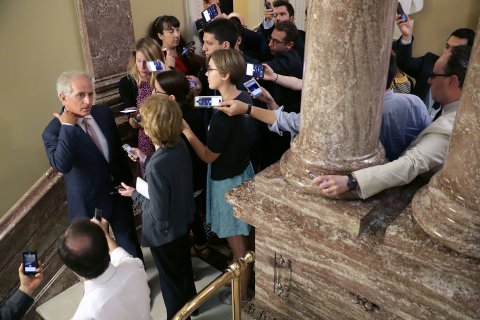It was a rare moment of optimism in Washington—and one that both parties could enjoy.
On a crisp fall day in 1986, President Ronald Reagan sat at a desk on a stage on the White House's South Lawn and signed a historic bill that changed the American tax code. Among its biggest backers: New Jersey Senator Bill Bradley, a Democrat, and New York Representative Jack Kemp, a Republican. Remarkably, the bipartisan law accomplished what lawmakers on the left and right had long advocated—eliminating crazy deductions and using that money to lower tax rates. "Millions of working poor will be dropped from the tax rolls altogether," Reagan said. "We're going to make it economical to raise children again. Flatter rates will mean more reward for that extra effort, and vanishing loopholes and a minimum tax will mean that everybody and every corporation pay their fair share."
More than 30 years later, Republicans and Democrats are trying to revive that bipartisan spirit, and some are optimistic—at least publicly—that a sweeping tax bill is possible. "It is time to unleash the full potential of the American economy by creating a tax code that actually works for the middle class," says House Speaker Paul Ryan. Treasury Secretary Steve Mnuchin agrees: "This is about creating a fair tax system that's good for the average, middle-class person." Earlier this summer, dozens of Democratic senators offered to work with the GOP on a tax bill, provided it didn't hurt the middle class.
Related: With Republicans in charge, Trump can't get anything done
Now for reality: The White House's plan to change the American tax system will likely wind up like the GOP's attempt to repeal and replace Obamacare—a partisan mess in which little or nothing gets done. If President Donald Trump really wants to change the tax system in any meaningful way, he'll have to dive into the swampiest part of the swamp: the place where special interests guard their bottom lines.

Tax breaks galore
The Trump team is probably aware of what it's up against, but that doesn't make it any easier. Mnuchin, for instance, says he's determined to repeal the federal deduction for state and local income taxes. More than 88 percent of it goes to earners making more than $100,000. (Mnuchin, who made more than $1 billion on Wall Street, has joked that his friends in New York and Connecticut will get hit the hardest.) That's overstating things, but this is the sixth-largest loophole, according to the nonpartisan Tax Foundation; it costs the federal government nearly $100 billion every year, which makes it a prime target for a cut.
But legislators from those high-state-income-tax states, not to mention their constituents, are going to fight such a move. Already, 70 House members have signed a letter to Mnuchin urging him to leave it alone. Other big tax breaks likely to be targeted are retirement plans such as 401(k)s, which run close to $200 billion annually. But these deductions have their backers, as well.
Taking on special interests will be even harder for the president. The tax code offers countless breaks for everything from small insurance companies to teacher expenses. You can read all about them here. Pretty much every item must be scrutinized if the White House hopes to slash rates. And these special interests will fight back. The ethanol industry is gearing up to protect its favorable treatment in the tax code. Native American tribes are working hard to make sure they preserve their exemption from certain kinds of federal taxation. Many others are doing the same.
Related: Will Democrats create new jobs?
The big problem is the numbers. The president wants to get the corporate income tax rate down to 15 percent from its current rate of 35, which on its face, is among the highest in the world. But doing that is incredibly expensive. Cutting rates to 15 percent would increase the federal deficit by more than $2 trillion within a decade. That's a lot of special interest deductions that would have to be cut. If Trump is going to lower rates, he'll at least have to take on some popular items like the 401(k) loophole—just as lawmakers did in 1986. And even Trump's allies in Congress have questioned whether the corporate tax rate could fall to even 25 percent without dramatically expanding the deficit.
Complicating matters is that Democrats insist that no middle-class voters get squeezed. They've also said any tax plan can't reduce or increase the overall amount of tax revenue the federal government takes in. Both of those goals will be difficult to achieve, given how the middle class benefits from the tax breaks without even knowing it. One of the largest giveaways is the exemption of employer contributions to health insurance. You don't get taxed on your boss's part of the bill, even though it's essentially income by another name. That costs the government $260 billion annually.
To Trump's chagrin, congressional leaders have already scuttled one way to potentially increase revenue. As late as July, lawmakers were considering a border adjustment tax on goods manufactured abroad, regardless of whether they were made by an American company. But congressional Republicans and the Trump administration couldn't agree on the terms. Nixing this kind of tax is a win for the conservative billionaires Charles and David Koch. (Several of the conservative groups they fund fought it.) It's also a blow to Trump's campaign promise to slap tariffs on goods made abroad.
Another big problem for Trump is that he's put so little work into developing a plan. Part of the reason the 1986 bill succeeded is because the Treasury Department under Secretaries James Baker and Donald Regan came up with detailed proposals that helped speed the process along. The Trump administration, however, has been mired in chaos and controversy. This past spring, Trump surprised his economic team by saying he was going to unveil a tax plan very soon. Mnuchin and other top officials scrambled and then put out a laughably vague statement that included things like "eliminate targeted tax breaks that mainly benefit the wealthiest taxpayers." Calling for vague cuts without knowing how to pay for them is like saying you're going to lose weight without diet and exercise.

Bruising budget fight
To be fair, there are a few reasons for optimism. Plenty of lobbying groups want to change the tax code. Americans for Prosperity, the Koch brothers–backed group, has an elaborate (and expensive) plan for drumming up support for a tax overhaul, including buying television ads in the home states and districts of Senate and House members who might be wavering. It kicked off its campaign at an August 2 event at the Newseum in Washington, D.C. Meanwhile, the American Action Network, a Republican-leaning group, is talking about spending $20 million to get a big tax bill passed. And mainstream business groups like the Chamber of Commerce and the Business Roundtable are pushing especially hard to lower the corporate rate, something many Democrats favor, too.
Related: When centrists ruled and Democrats won
Yet to get a tax plan through committees and the House and Senate this fall, Congress must first resolve a contentious budget battle. And that's going to be a partisan mess. The federal government will need to raise the debt ceiling by September 29 to avoid a potentially catastrophic blow to the financial markets, which would call into question the faith and credit of the U.S. to pay its debts. Like administrations before it, the Trump White House wants a "clean" debt limit hike—one with no preconditions. But Republicans and Democrats have plenty in mind, especially the GOP, which wants to use the debt ceiling to cut spending and fund a border wall. If the congressional calendar is too cluttered, forget about a new tax plan.
Congress wasn't all hugs and smooches in '86, but it was a much less divided place. Party leaders had far more control over their unruly members. There were plenty of centrists willing to work with the other side. And even then, lobbyists nearly destroyed the bill, and they later succeeded in clogging up the tax code with new deductions.
It's going to be much, much harder this time, and Donald Trump is no Ronald Reagan. In all likelihood, the best we can expect is a reduction in the corporate rate. But real changes to the tax code for businesses and individuals? The swamp will prevail.















